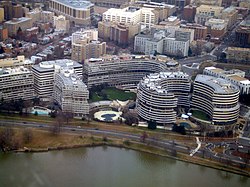This is an old revision of this page, as edited by Jacquelineorussell (talk | contribs) at 16:37, 24 July 2009 (Robert Macnamara, resident. Placido Domingo, resident, Caspar Weinberger). The present address (URL) is a permanent link to this revision, which may differ significantly from the current revision.
Revision as of 16:37, 24 July 2009 by Jacquelineorussell (talk | contribs) (Robert Macnamara, resident. Placido Domingo, resident, Caspar Weinberger)(diff) ← Previous revision | Latest revision (diff) | Newer revision → (diff) United States historic place| Watergate | |
| U.S. National Register of Historic Places | |
 The Watergate complex in Washington, D.C. The Watergate complex in Washington, D.C. | |
| Location | Washington, D.C. |
|---|---|
| Area | Foggy Bottom |
| Built | 1962 |
| Architect | Moretti, Luigi; Timchenko, Boris, et al. |
| Architectural style | Modern Movement |
| NRHP reference No. | 05000540 |
| Added to NRHP | October 12, 2005 |
The Watergate complex is an office-apartment-hotel complex built in 1967 in northwest Washington, D.C., United States, best known for being the site of burglaries that led to the Watergate scandal and the resignation of President Richard Nixon.
Location
The Watergate superblock is bounded on the north by Virginia Avenue, on the east by New Hampshire Avenue, on the south by F Street, and on the west by the Rock Creek and Potomac Parkway. It is in the Foggy Bottom neighborhood overlooking the Potomac River, adjacent to the Kennedy Center and the embassy of Saudi Arabia. The nearest Metro station is Foggy Bottom-GWU.
History
The complex was developed by the Italian firm Società Generale Immobiliare, which purchased the 10 acres (40,000 m) that constitute the plot of land on the defunct Chesapeake and Ohio Canal in the early 1960s for US$10 million. Italian architect Luigi Moretti designed the six buildings on the site: a hotel, two office buildings, three apartment buildings and a retail center. The name of the complex was derived from the terraced step area to the west of the Lincoln Memorial that leads down to the Potomac River. The steps used to face a floating performance stage on the Potomac River, creating an amphitheater. This area was originally planned as the official reception area for all dignitaries arriving in Washington, D.C. by water.
Individual buildings at the Watergate

The Watergate Hotel is located at 2650 Virginia Avenue NW. It has 250 guest rooms and 146 suites. In 2004, the hotel was purchased by a company planning to turn it into luxury co-ops. The hotel closed on August 1, 2007 for a $170 million 18-month renovation., planning to reopen to guests in late 2009. However, the owners, Monument Realty, defaulted on their loan at the end of June, 2009 and it is currently headed for foreclosure. The 30 day notice for forecolsure expires 7/16/2009 and an auction was scheduled for 7/21/2009. The auction failed to draw any bids, and the hotel will remain closed as PB Capital Corporation, who loaned $40 million to Monument Realty to purchase the hotel, will take possession the hotel and continue to search for a buyer.
The two Watergate Office Buildings are at 600 New Hampshire Avenue NW and 2600 Virginia Avenue NW. In 1972, the Democratic National Committee had its headquarters on the sixth floor of the 11-story 2600 Virginia Avenue building. On May 28, 1972, a team of burglars working for Nixon's re-election campaign put wiretaps and took photos in and near the DNC chairman's office. The wiretaps were monitored from rooms at the Howard Johnson's Motor Lodge hotel across the street at 2601 Virginia Avenue NW. (The hotel is now owned by The George Washington University. It is used as a dormitory for graduate students, and is known on campus as "HOVA", or "Hall on Virginia Avenue".) During a second burglary on June 17, 1972, to replace a malfunctioning "bug" and collect more information, five burglars were arrested and the Watergate scandal began to unfold.
The Watergate Office Building was sold in 2005 by Trizec Properties to BentleyForbes, a Los Angeles-based real estate investment firm run by C. Frederick Wehba, for $86.5 million. The complex, consisting of the buildings at 2500, 2600, and 2650 Virginia Ave. NW and 600 and 700 New Hampshire Ave. NW, was listed on the National Register of Historic Places on October 21, 2005.
The three Watergate Apartment buildings total some 600 residential units. Past occupants have included Ruth Bader Ginsburg, Placido Domingo, Caspar Weinberger, former Secretary of Defense Robert Macnamara, Bob and Elizabeth Dole, Monica Lewinsky, Betty Currie, Ben Stein, Clare Boothe Luce, and Paul O'Neill. Former Secretary of State Condoleezza Rice now lives in the Watergate South..
There is a small (63,000 sq ft. / 5900 m²) retail center (which offers a Safeway supermarket and a CVS pharmacy) in the basement level, and several upscale shops and restaurants at street level.
See also
References
- "National Register Information System". National Register of Historic Places. National Park Service. 2006-03-15.
- Kelly, John. "Answer Man: A Gate to Summers Past." The Washington Post. December 13, 2004.
- "Watergate Hotel Shuts Down to Spruce Up". Retrieved 2007-11-06.
- "The Watergate burglaries and HoJo's room 419". Retrieved 2008-01-17. Includes photos showing the Watergate Office Building, as viewed from one of the burglars' rooms at the Howard Johnson's Motor Lodge.
- "The George Washington University's page on the Hall on Virginia Avenue, fmr. Howard Johnson Hotel". Retrieved 2008-09-28.
- "National Register of Historic Places Listings - October 21, 2005". Retrieved 2007-03-27.
- "BentleyForbes takes Watergate office property off the market", Washington Business Journal, May 29, 2008.
External links
- The Watergate Hotel official website
- Bentley Forbes official website
- Livingston, Mike. "Watergate: The name that branded more than a building," Washington Business Journal, June 14, 2002
38°53′56″N 77°03′20″W / 38.8987652°N 77.055552°W / 38.8987652; -77.055552
Categories: